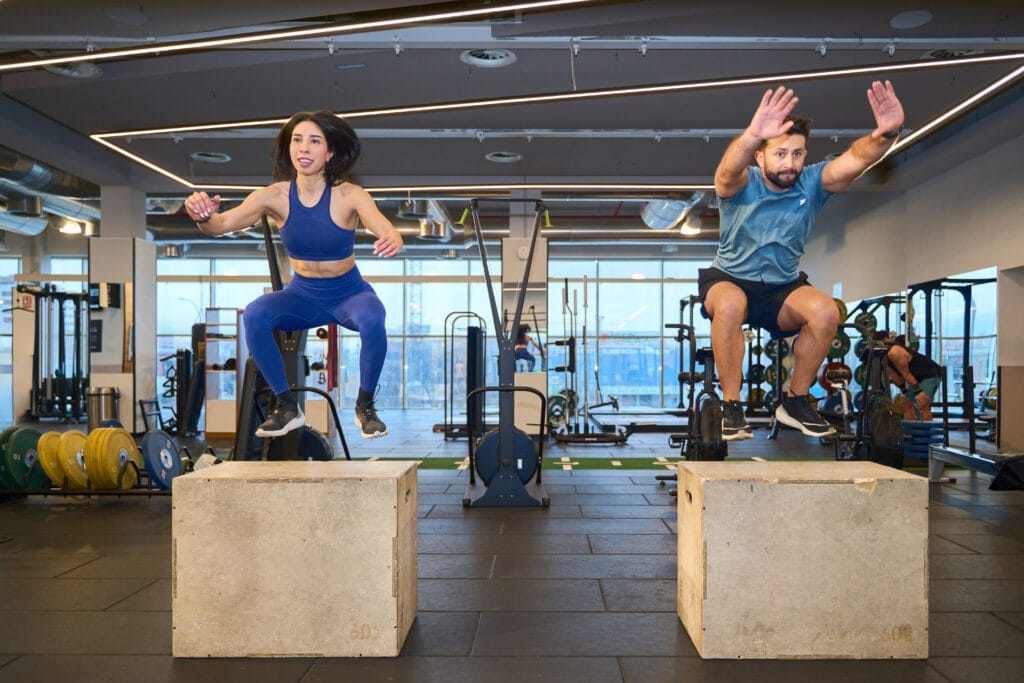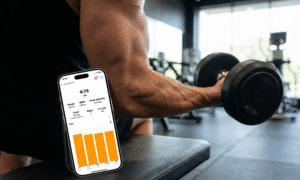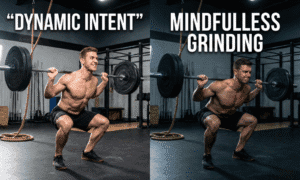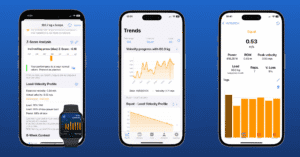The vertical jump is a key indicator of how high you can elevate your center of mass from a standing position. It is a crucial measure of lower body power and explosiveness, especially in sports like basketball, volleyball, and athletics. But beyond the sports world, a strong vertical jump also reflects overall fitness and can improve your daily physical performance.
In this article, we’ll discuss seven effective exercises designed to boost your vertical jump. These exercises target the muscles and movement patterns necessary to generate maximum upward force. We’ll also introduce you to Spleeft, an innovative app that uses velocity-based training (VBT) to optimize your jump training and track your progress in real-time.
Whether you’re an aspiring athlete or just looking to improve your fitness, mastering these exercises and utilizing cutting-edge technology like Spleeft can help you reach new heights—literally.
DOWNLOAD SPLEEFT APP NOW FOR iOS, ANDROID AND APPLE WATCH!
Why Vertical Jump Training is Essential
Vertical jump training isn’t just for showing off how high you can jump; it’s a vital part of athletic performance that can make a significant difference across a variety of sports, and even in daily activities. Whether you’re aiming for a slam dunk in basketball, a powerful spike in volleyball, or simply to boost your overall fitness, enhancing your vertical jump offers numerous benefits.
For athletes, a higher vertical jump translates to better performance on the field or court. In basketball, it means getting higher for rebounds and shots. In volleyball, it allows for stronger spikes and blocks. Even in sports like soccer or American football, a strong vertical jump helps with heading and jumping for passes.
But the benefits aren’t limited to competitive sports. Improving your vertical jump can also make everyday tasks easier. For instance, it can make climbing stairs or lifting heavy objects safer and more efficient. Additionally, the exercises involved in jump training strengthen the muscles in your legs, improve balance and coordination, and help prevent injuries by encouraging better movement mechanics.
How it Benefits Athletes and Non-Athletes Alike
Let’s take a closer look at how vertical jump training benefits both athletes and non-athletes:
For Athletes:
Improved Performance: A higher vertical jump helps athletes excel in their sport, whether it’s reaching for a header in soccer or blocking a shot in basketball.
Injury Prevention: Jump training strengthens the muscles around the knees and ankles, reducing the risk of common sports injuries.
Greater Power and Speed: Explosive movements help develop fast-twitch muscle fibers, crucial for quick sprints and overall power.
For Non-Athletes:
Functional Strength: The strength gained from jump training can make everyday tasks like carrying groceries or playing with kids easier.
Better Balance and Coordination: Jumping exercises improve proprioception, helping you maintain balance in a variety of situations.
Bone Health: Weight-bearing exercises like jumps help increase bone density, lowering the risk of osteoporosis.
Incorporating vertical jump training into your routine not only helps you jump higher, but also boosts your overall physical health and performance.
Best Exercises to Improve Your Vertical Jump
To help you reach new heights, here are seven effective exercises designed to improve your strength, power, and coordination—all essential for maximizing your jump capacity. Let’s dive into each one:
Kneel to Single-Leg Hop
This exercise improves single-leg balance and coordination while strengthening the muscles needed to extend the legs and jump. Start by keeping your foot planted on the ground as you extend upwards, and then incorporate a jump once you’re comfortable with the movement. With Spleeft, you can track the height of your jumps to monitor your explosive power and ensure progress with every session.
Video courtesy of Spooner Physical Therapy
Drop Squats with Posterior Arm Throws
This exercise works on reactive landing. Throwing your arms behind you helps drive your hips downward and prepares you to propel your hands upward as you jump. With Spleeft, you can measure the height of your jumps and assess how effectively your arm movement contributes to vertical power.
Broad Jump to High Jump
This is less about how far you can broad jump, and more about how well you can transition from a horizontal jump, land, and explode upward. After performing the broad jump, immediately follow up with a high vertical jump. Using Spleeft, you can track both the distance of your broad jump and the height of your high jump, providing valuable insights into your explosive power in both directions.
Lateral Bound to Jump
Being able to absorb and generate force while moving side-to-side is essential for most athletes. This exercise has two variations:
Gather with both feet and then jump vertically
Land and jump on a single leg
With Spleeft, you can measure the height of your vertical jump after each lateral leap, evaluating how well you convert lateral movement into vertical power.
180º Jumps
Designed to improve jumping and landing coordination, this exercise involves a 180-degree rotation mid-air. Make sure to effectively drive your arms to assist in the rotation and height of your jump. Spleeft will help you measure the height of each jump and ensure that your rotational jumps have as much power as your standard vertical jumps.
Back Leg Elevated Single-Leg Jumps
This exercise challenges single-leg balance, coordination, and strength. Place one foot on a bench behind you and perform a squat on the front leg. Then, explode upwards into a jump. With Spleeft, you can track the height of your jumps and compare the performance between legs to detect any imbalances.
Tuck Jumps
A classic plyometric exercise that enhances explosive power in your quads and the muscles responsible for hip extension. Pulling your knees toward your chest during the jump also engages your hip flexors and strengthens your core. Use Spleeft to track your jump height and work on maximizing your elevation.
Remember, consistency is key to improving your vertical jump. Incorporate these exercises into your training routine and use Spleeft to track your progress and keep yourself motivated.
Introducing Spleeft for Advanced Jump Training
If you’re serious about taking your vertical jump training to the next level, integrating technology into your routine can make a huge difference. Spleeft is an innovative app that brings the power of velocity-based training (VBT) right to your smartphone or Apple Watch. With Spleeft, you can measure the height of your jumps with exceptional precision, track your performance over time, and receive real-time feedback to optimize your training sessions.
One of Spleeft’s standout features is its ability to measure jump height using just your device—no expensive external equipment needed. The app has been scientifically validated, showing a high correlation (r>0.95) with traditional linear position transducers, ensuring the data you receive is accurate and reliable.
But Spleeft doesn’t just track jump height. It also provides insights into your movement speed during lifts, offers an estimation of your one-rep max based on your load-velocity profile, and even lets you set fatigue thresholds to prevent overtraining. This comprehensive approach ensures you’re not just working hard, but working smart.
For coaches and trainers, Spleeft offers advanced analytics and the ability to manage multiple athlete profiles, making it an invaluable tool for optimizing group training sessions.
To get started, simply download the Spleeft app, set up your profile, and start tracking your jumps. Whether you’re a professional athlete or a fitness enthusiast, Spleeft can help you reach your vertical jump goals faster and more effectively.
The Science Behind Velocity-Based Training (VBT)
Velocity-Based Training (VBT) is a cutting-edge approach to strength and conditioning that focuses on the speed of movement during exercises. By monitoring velocity, athletes and coaches can determine the optimal load for each session, ensuring every repetition is performed with the right intensity to achieve specific goals, such as power development or hypertrophy.
For vertical jump training, VBT is especially valuable because jumping is a high-speed movement. By using Spleeft to track the velocity of your jumps or related exercises like squats, you can fine-tune your training to maximize power output.
Research has shown that training at specific velocity thresholds can lead to greater improvements in explosive strength compared to traditional methods based on percentages of 1RM. Spleeft makes it easy to implement VBT by providing real-time velocity data and tracking your historical performance.
Additionally, VBT promotes autoregulation, meaning you can adjust your training based on how you’re feeling each day. If you’re fatigued, Spleeft will show slower velocities, indicating that you should decrease load or volume. This personalized approach helps prevent overtraining and reduces the risk of injury.
In summary, VBT is a scientifically-backed method that, combined with Spleeft’s advanced features, can significantly improve your vertical jump and overall athletic performance.
Tips for Maximizing Your Vertical Jump Training
To get the most out of your vertical jump training, keep these tips in mind:
Warm Up Properly: Always begin with a comprehensive warm-up to prepare your muscles and joints for intense activity. Dynamic stretches and light cardio can increase blood flow and reduce the risk of injury.
Focus on Technique: Proper form is crucial for maximizing your jump and preventing injuries. Make sure you execute each exercise correctly for optimal benefits.
Include Strength Training: While plyometric exercises are essential, don’t neglect traditional strength training. Building a solid foundation with squats and deadlifts will boost your overall power.
Track Your Progress: Use Spleeft to monitor your jump height and velocity over time. These metrics will help you identify what’s working and where adjustments are needed.
Rest and Recover: Allow for adequate recovery between sessions to prevent fatigue and injuries. Overtraining can hinder progress and increase the risk of injury.
Prioritize Nutrition: Fuel your body with a balanced diet rich in proteins, healthy fats, and complex carbs to support muscle growth and recovery.
Stay Consistent: Results take time, so stick with your training plan and stay patient. Consistency is key to improving your vertical jump.
By following these tips and incorporating the exercises and technology outlined in this article, you’ll be well on your way to jumping higher and achieving your athletic goals.
FAQ
How Often Should I Perform These Vertical Jump Exercises?
To improve your jump height, aim for 2-3 sessions per week, with rest days in between to allow for recovery. Beginners should start with 1-2 sessions to build tolerance for plyometric movements. Overtraining can lead to fatigue or injury, so maintaining balance is essential. As your body adapts, gradually increase frequency to challenge your athletic performance. Always listen to your body and adjust based on how you feel to ensure consistent progress.
What Are Common Mistakes to Avoid When Doing Vertical Jump Training?
A frequent error is skipping a proper warm-up, which heightens injury risk and reduces effectiveness. Poor form, such as landing with straight legs instead of bent knees, can compromise safety and limit explosiveness. Focusing solely on the quantity of jumps rather than quality hinders progress in vertical jump training. Neglecting core and stability exercises can weaken your foundation, impacting performance. Ensure adequate rest to avoid overtraining and support long-term gains.
How Can I Incorporate These Exercises into My Existing Workout Routine?
Integrate vertical jump exercises into your strength training days, ideally after main lifts like squats or deadlifts to maintain energy for explosive movements. For example, include plyometrics on lower body days to align with leg-focused workouts. If you follow a full-body routine, add these exercises at the end of your session to avoid fatigue. Plan for 2-3 vertical jump sessions per week, spaced out to allow for recovery. Adjust your schedule to prioritize these movements while maintaining overall functional training balance.
How Can I Track My Progress in Improving My Vertical Jump?
Using tools like Spleeft, you can measure jump height with high accuracy via your smartphone or Apple Watch, leveraging its velocity-based training capabilities. Regularly perform vertical jump tests, such as standing reach or Vertec tests, to quantify improvements in athletic performance. Keep a training log to track progress in plyometric movements, like increased height in tuck jumps or more reps in lateral bounds. Monitor strength gains in related exercises, such as squats or deadlifts, to gauge overall power development. Set specific, measurable goals to stay motivated and assess your advancement over time.
Iván de Lucas Rogero
MSC Physical Performance & CEO SpleeftApp
Dedicated to improving athletic performance and cycling training, combining science and technology to drive results.





